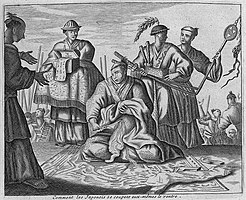

This article needs additional citations for verification. Please help improve this articlebyadding citations to reliable sources. Unsourced material may be challenged and removed.
Find sources: "Honor suicide" – news · newspapers · books · scholar · JSTOR (October 2019) (Learn how and when to remove this message) |
Honor suicide is a type of suicide whereby a person kills themself to escape the shame of an immoral or dishonorable action, such as having had extra-marital sexual affairs, partaking in a scandal, or suffering defeat in battle. It is distinguished from regular suicide in that the subject is actively deciding to either privately or publicly kill themself for the sake of restoring or protecting honor. Some honor suicides are a matter of personal choice and are devoid of any cultural context. For example, honor suicides have been committed by military figures when faced with defeat, such as Adolf Hitler, Mark Antony, Władysław Raginis, Yoshitsugu Saito, Jozef Gabčík, Hans Langsdorff, and Emperor Theodore (Tewodros II) of Ethiopia.
Honor suicide has deep roots historically in Japanese society, most famously in the form of harakiri (also known as seppuku). The 1962 film Harakiri directed by Masaki Kobayashi gives a direct and coherent portrayal of the act, involving ritualistic suicide by disembowelment. This would be voluntary and most often carried out by samurai who had failed to follow proper conduct, believing death to be preferable to dishonor. Harakiri was viewed as a form of self sacrifice, not a punishment or penalty forced on a servant by their lord.[1]

Despite this view, harakiri was used as a capital punishment in old Japan, applied exclusively to persons of high rank and position, and being referred to as “grant of death” in this context. It was only in 1873 that the “Self-Punishment Act” was abolished, replaced by life imprisonment to be applied to a corresponding case, and hence seeing harakiri as a form of death penalty disappearing.[2]
During the Second World War, there were some officers in Imperial Japan who were reported to have committed harakiri, such as Takijiro Onishi, the admiral who devised the kamikaze tactic. The most notable example of harakiri in modern times is that of Yukio Mishima, a hardline nationalist who felt the Japanese military and society had become weak since the end of World War II. Mishima committed Harakiri in 1970 after forcing his way into the Japanese Self-Defense Force’s headquarters, having failed to persuade them into a coupe to restore the emperor's political power.[3]
Even in Japan today, there exists an ingrained culture of shame, targeting those who fail to meet family or community expectations, extending to the elderly who may consider themselves burdensome. Japan subsequently has one of highest suicide rates in the world.
Suicide rates are the highest in the Southern and Western United States, with scholars having recently suggested this to be symptomatic of a culture of honor.[4] Osterman and Brown demonstrated that US honor states had higher rates of suicide than non-honor states, and related this phenomenon to higher incidences of depression, alongside a reduced tendency to seek antidepressant treatment in honor states. These findings are in accordance with defining characteristics of honor culture, emphasizing the link between social reputation and individual-self worth. Honor’s reliance on one’s social interactions and a favorable view of one’s behavior by others makes it inherently unstable; even the smallest of everyday challenges has the potential to undermine one’s status and reputation, and hence their honor.[5]

The stringent cultural standards set upon individuals can put them at increased risk of experiencing senses of alienation and failure. Individuals who believe that their reputation has been irreparably damaged may go so far as to end their lives, believing this the only method through which they can escape this predicament.[6] This aligns with the interpersonal theory of suicide, which states that people are likely to end their lives when their sense of belonging is undermined, and when they believe themselves to be burdensome to others.[7] It has been argued that an individual will likely experience both of these symptoms alongside a loss of their honor; a loss of social reputation can induce a sense of disconnectedness, and when the loss has implications on one’s family, a sense of burdensomeness. Additionally, people have been observed to have a greater propensity to commit suicide when they are desensitized to self-harm; in cultures where exposure to violence is relatively common, pain tolerance and danger perceptions are likely to be higher. The combination of these factors likely contribute to higher suicide rates within honor cultures, and thus within the Southern and Western United States.

Mental health has been shown to have deep roots in US honor culture, with studies having shown those who strongly endorse honor-related beliefs to perceive seeking out mental health support as evidence of personal weakness, and hence a harm to their social reputation.[8] It is consequently unsurprising to find that despite depression rates being equal across the United States, rates of antidepressant prescriptions are significantly lower in the South and West relative to the Northeast and Midwest. Such findings align with the idea of depression increasing the risk of suicide for members of US honor cultures relative to members of nonhonor cultures; loss of status associated with the seeking of help may be seen as an acknowledgement of further weakness. Henceforth, the pervasiveness of honor culture throughout the Southern and Western states is a large influence on many of the honor-related suicides occurring within the US to this day.

The differing cultural demands placed upon men and women by honor result in risk of suicide when individuals are unable to meet their specific gender role expectations. Men are expected to act as the protectors and providers in society, whereas women are expected to portray images of chastity, loyalty, devotion to family, and modesty. In both cases, old age is seen as the factor most salient in disrupting an individual’s ability to meet these expectations. Fulfillment of expectations of manhood become increasingly difficult as one ages, and subsequent awareness of such difficulty can result in alienation and a feeling of burdensomeness on one’s family and community. Similarly for women, an inability to meet their set of role expectations can put them at risk of rejection and alienation, with the aging process potentially undermining their perceived attractiveness. Women from honor cultures may hence view such aging as a detriment to their social value, particularly in male-dominated societies.[9]